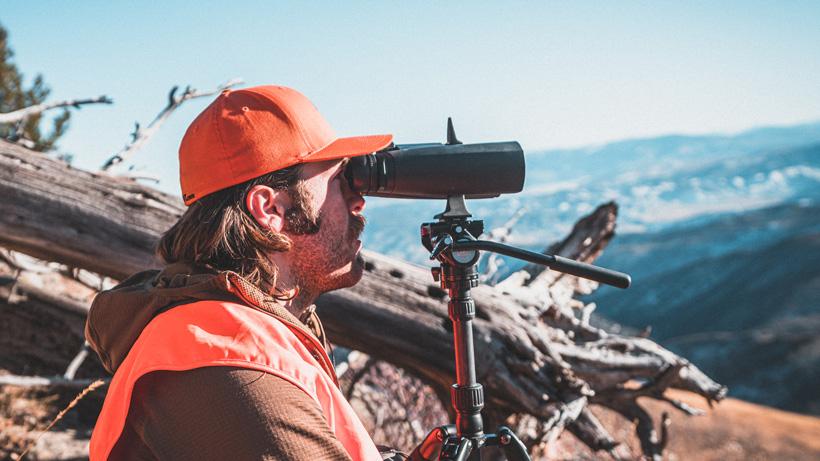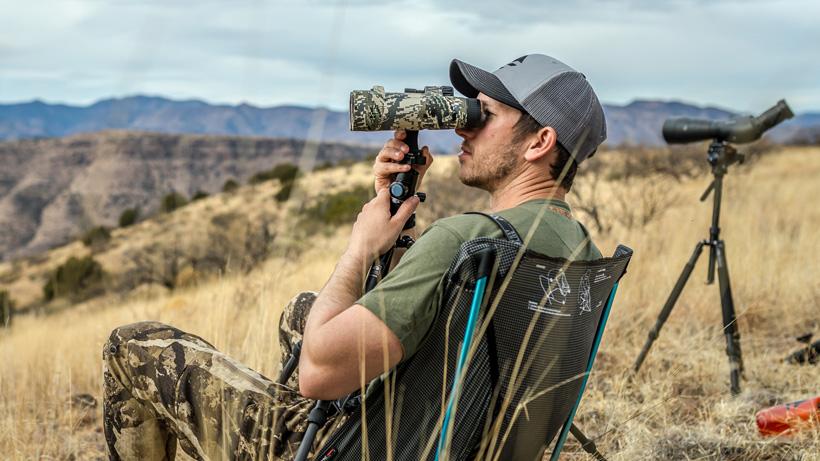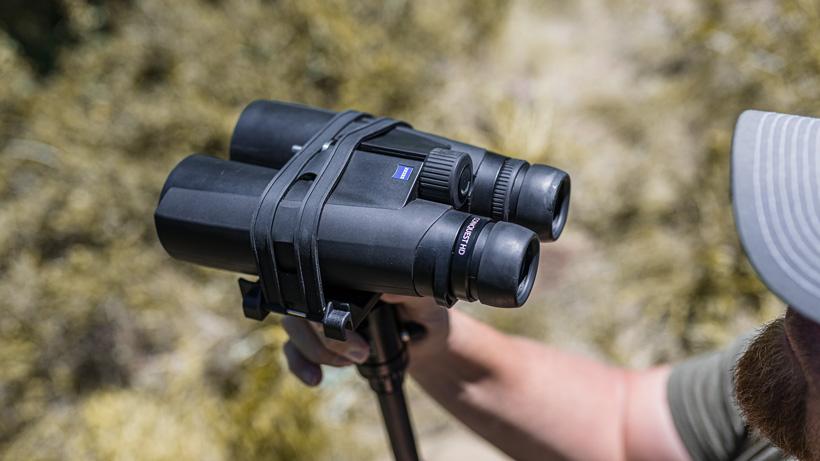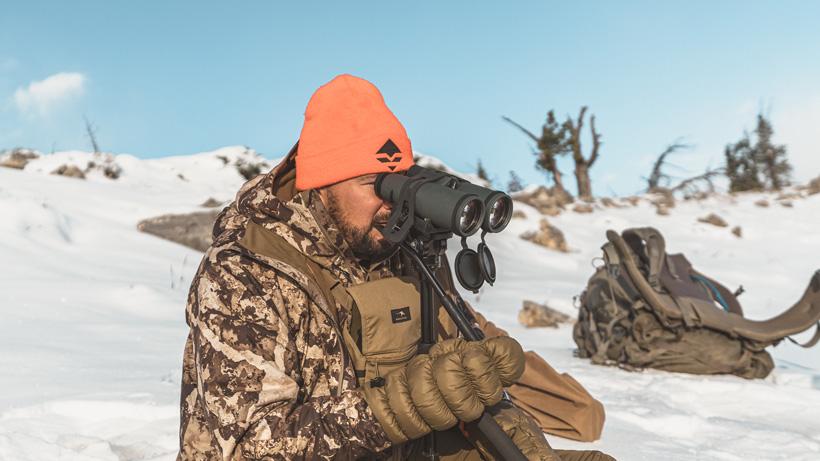





Glassing with Leupold BX-5 Santiam HD 15x56 binoculars for deer.

Summer scouting with Zeiss Conquest 15x56 binoculars.

Swarovski SLC 15x56 binoculars on a cold morning of glassing.

Should you get 15 or 18 power binoculars? Pictured above are Vortex Razor UHD 18x56 binoculars. All photo credits: Brady Miller
Growing up hunting in Arizona, I have used my fair share of binoculars over the last 40 years. Glassing for game has always been a preferred and effective method for western big game hunting and, like most methods, they have evolved over time. Hunters today are using binoculars and glassing for their quarry, either using lighter 10x binoculars carried around their neck, or today’s hunters are scouring the mountains of the West with large, tripod-mounted 15x or 18x power binoculars that allow them to look at distant ridges or the dark shadows of a north-facing slope. Either way, hunters today are getting better at glassing!
In the past, some very dedicated hunters used these big binoculars to hunt Coues deer in the mountains of south central Arizona and their ability to find game using this type of binoculars spread, becoming almost legendary. However, these large binoculars were hard to come by and usually very expensive. Yet, as time went by — and reputation grew — these large power binoculars and their effectiveness made their way into mainstream hunting.
Today, most companies that make binoculars have a 15x or 18x magnification as part of their offering. Fortunately, I have looked through the vast majority of these optics with my own eyes in the field. Not all of them, of course, but most!
Know that when buying big glass the price is going to vary immensely, ranging from $499 to $2,299, depending on the brand and model. I can’t tell you how to spend your money, but I have always recommended that hunters buy the best glass that they can afford. Your eyes will thank you for it. Of course, the better the glass, the more expensive it becomes. However, better glass allows your eye to focus more precisely over a longer period of time. Along with a tripod, better glass will minimize eye fatigue. Now, this does not mean you will not find game because you have lesser glass, but, rather, your choice of glass will provide a less sharp focus, transmit light less efficiently in low light conditions, and not be as clear at the edges.
Glassing with Leupold BX-5 Santiam HD 15x56 binoculars for deer.
Let your eyes be the judge.
The brands we offer in this power range in the GOHUNT Gear Shop are Swarovski, Zeiss, Vortex and Leupold. When choosing one of these bigger binoculars, here are a few things to think about. One, these optics are all big. They range in height from 7.6” to 8.3’” tall. On average, they are 2.1” taller than the average 10x binocular. They are all heavy. The lightest comes in at 2 lbs, 9.6 ounces and the heaviest at 2 lbs, 13 ounces. Again, on average, that is at least 1 lb heavier than the average 10x binocular.
My point? They are all big and heavy!
Yet, the biggest difference in these bigger binoculars is their magnification. There is a 17% difference in power between a 15x and 18x power binocular. At 1,000 yards, that is 170 yards closer with 18x than 15x. At 2,000 yards, that 340 yards closer. That is pretty significant. To some, that power may be more important. For instance, there are a lot of hunters who despise using a spotting scope because it bothers them to keep one eye closed for long periods of time. Others may feel less coordinated when tracking and following with a higher power spotter. Several customers purchase big glass for this reason alone. It is true that because we see in bi-optic vision, our eyes see more detail with both eyes sharing the load instead of one.
Summer scouting with Zeiss Conquest 15x56 binoculars.
The average field-of-view (FOV) with the 15xs is 233’ at 1,000 yards. The FOV with the 18xs is 194’ at 1,000 yards. That is a difference of 17% FOV. Some might feel that is too much to lose when looking at closer distances and would benefit from the wider FOV of the 15x. If the distance is longer and the FOV is less important to you, then detail or a larger image from the 18x might be better for your purpose. Again, this is why I always say get your eyes behind the glass and try them for yourself.
For me, the exit pupil measurement is one of the most important and noticeable differences between the 15xs and 18xs. Why? Because this measurement describes the amount of light that reaches your eyes. The exit pupil is the width of the band of light leaving the ocular lens and hits your eye. To calculate the exit pupil on any binocular, divide the objective lens (56mm) by the power of the binocular (15 or 18 ). The bigger the number means the more light reaching your eyes for a brighter image. The 15xs have an exit pupil of 3.73 mm while the 18xs have a 3.1 mm exit pupil. 4 mm has long been considered optimum. For comparison, most of your 10x42 binoculars have an exit pupil of 4.2 mm. When choosing between 15x and 18x, I appreciate less magnification with a brighter image.
Swarovski SLC 15x56 binoculars on a cold morning of glassing.
The difference in magnification may seem small and insignificant. Depending on your style of hunting or the number of pieces of optics in your arsenal, that 3x difference may be a big deal. I get asked this question almost every day. Personally, I prefer the 15xs with a little wider FOV and a little brighter image. However, that is what works for me, the way I hunt and the optics I carry. You may like the power and bigger image. That is what matters most!